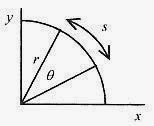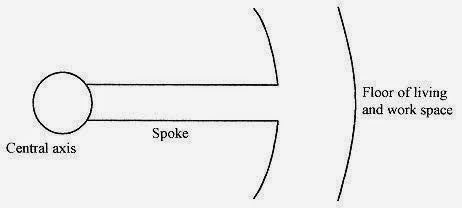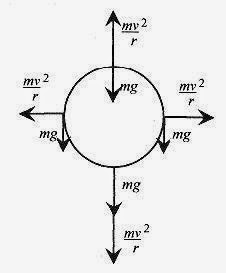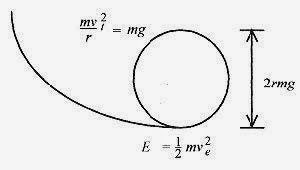Rotational Motion
The study of rotational motion begins with the kinematics of the motion, that is, the relation between angle, θ, angular velocity, ω, and angular acceleration, α. Start with a point rotating about the origin of a coordinate system, usually an x – y system, with r-0 superimposed.
Begin with the definition of radian measure as angle equals arc length over radius. This gives the angle as a pure number, or radians. Radian is a phantom unit, sometimes it is used and sometimes not. For example, for an arc length of 4m on a circle of radius 2m the angle in radians is 4 m / 2 m=2. This is usually written as 2 rad. In a problem involving canceling units this can add confusion because rad is length over length or unity and does not cancel with anything. So rad may appear in a problem, then disappear in the answer, or vice versa, thus fitting the description (phantom.) When radian is used in a problem, the unit is for clarity and will not necessarily be in the final answer.
The kinematic angular equations can be written as direct analogs to the linear ones.
Another set of relationships in rotational motion is the one between linear motion and angular motion. These relate the motion of a particle, or point, along a circular path to the angular motion. Position along the circular path is called the linear position or rim position. These relationships come out of the definition of radian measure, θ=s / r or s=rθ. For constant r, a small change in s is related to a small change in θ by Δs=rΔθ; and if the change is over time, then Δs/Δt=r(Δθ/Δt) or v=rω, relating the linear velocity, the velocity of a point on the rim, to the angular velocity. For a small change in linear velocity Δv=rΔω; and if this occurs over time Δv/Δt=r(Δω/Δt) or a=rα, relating the linear acceleration, the acceleration of a point on the rim, to the angular acceleration. Formal definitions of angular velocity and angular acceleration are in the next chapter.
There is one more relationship in angular motion. If a point is rotating on a circle with constant angular velocity ω, the linear velocity is numerically constant. But velocity is a vector; and while the number associated with the linear velocity is not changing, the direction is changing. Refer to Fig. 11 2.
The vectors v and v’ are separated by an angle θ. The acceleration is the difference between the vectors. Remember, the vectors v and v’ are at right angles to the radius, so the angle between v and v’ is the same as the angle between the r’s. Drawing the figure for the r’s and another figure for the v’s, with the v’s placed tail to tail, we have similar triangles (isosceles triangles with the same angles). For small angles, Δs approaches a straight line so comparing the similar triangles write
In the limit Δs / Δt is v and Δv / Δt is a, so the acceleration is
The acceleration vector points inward along r. Refer to Fig. 11 2 and note that in the limit as Δt 0, Δs 0, and Δv 0, Δv and a point toward the center of the circle. These are all the relations necessary to do problems in rotational motion.
Use this sample problem to become familiar with manipulating revolutions, revolutions per minute, and radians. A wheel is rotating on its axis at 100 revolutions per minute. This is usually written as 100 rev / min. The angle turned through in each minute is 100 times 2ƒÎ (radians). This little calculation is often missed in rotation problems. Each revolution represents an angle of 2ω measured in radians.
The angular speed is θ=2ƒÎ.100rad/min,
Converting to seconds ω=(2ƒÎ.100rad/min)(1 min/60s)=(10ƒÎ/3)(rad/s).
Assume the wheel slows, under constant acceleration, to zero in 3.0 minutes.
Calculate the acceleration as
Angular velocity is usually written with the units (rad/s) or (1/s) and angular acceleration as (rad/s2) or (1/s2), which is why radian is called a phantom unit. Radians and revolutions are usually introduced as units for convenience in understanding a problem and not as units to be carried and manipulated, as is the case with kg, m, s, etc. Be very careful on this point. It can cause you trouble!
The angle turned through is the average angular velocity times the time.
or
<><><><><><><><><><><><>
An automobile is traveling at 60km/hr. Calculate the angular velocity of the 0.35m radius wheels.
Solution: The linear velocity of the (contact) point on the wheel is![]()
The linear velocity of the contact point on the wheel is the same as the velocity of the axle.
Adding radians in the units makes the meaning clearer.
<><><><><><><><><><><><>
If the automobile of problem 11 1 accelerates uniformly from 60km/hr to 80km/hr in 3.0s, what is the angular acceleration?
Solution: This acceleration is the acceleration of the point where the wheel meets the road. First calculate the change in velocity.
This is the change in velocity of the point on the wheel. The linear acceleration, is
The angular acceleration is
<><><><><><><><><><><><>
A disk rotating at 30rad/s slows to 20rad/s while turning through 60 revolutions. How long does this take?
Solution: Since the acceleration is constant we can use![]()

<><><><><><><><><><><><>
11 4 For the acceleration of the disk in problem 11 3, how many revolutions does it take for the disk to stop?
Solution: First, calculate
Now use ω2= ω 02+2αθ with ω=0 and ω0=30 rad/s to find θ:
Applications
From kinematics we can go to some more complicated rotational problems.
Consider a space station in the form of a donut with a rectangular cross section connected by spokes to a central axis. The gfloorh is the inside of the outer wall. How fast would a 300 m radius station have to rotate to duplicate the gacceleration due to gravityh on the surface of the earth?
Solution: The required acceleration is the v2/r acceleration associated with rotational motion. Since v is related to ω by v=rω, then the required acceleration a=v2/r=rω2. Set this acceleration equal to 9.8m / s2 and solve for ω.
The frequency in revolutions per minute is
Notice that in this last calculation grevh was introduced for clarity.
<><><><><><><><><><><><>
11 6 If someone of weight 800N (on earth) living in the space station described in problem 11 5 were to move one half the radius in toward the axis of rotation, what would be their weight at this radius?
Solution: Their weight, what a force meter placed between them and a gfloorh would read, in this environment would be
If the person in the space station were placed in a gblack boxh where they were unaware of their surroundings, there is no experiment they could perform to determine whether their weight were produced by the mv2 / r of the space station or mg of the earth or any other planet.
Consider astronauts in earth orbit. From the reference frame of the astronauts the mv2 / r force is balanced by the gravitational force of the earth. This lack of force, or weightlessness, has a dramatic effect on the bodies of earth orbiters who typically ggrowh 2 to 3cm in earth orbit.
Many physics textbooks treat all problems involving centripetal force from an external reference point. This may sometimes be confusing. Keep this clear in your mind; from the reference point of the external observer there is no gcentrifugalh force, or force that acts radially out. However, in many instances the most practical way of solving uniform circular motion problems is from the point of view of the object being rotated. Operationally this means to treat them as force balance problems in which mv2/r acts radially out. Look back to problem 5.16 where the coin is rotating on the turntable. If you were riding on the coin at constant angular velocity you would say there is no unbalanced force in the radial direction; the mv2/r force acting out is balanced by the ƒÊN force acting in.
<><><><><><><><><><><><>
11 7 Consider a mass of 2.0kg being whirled in a sling in a horizontal circle. The period of rotation is 1.0s, and the radius 1.0m. What is the tension in the cord?
Solution: The force that makes the mass travel in a circle must be equal to mv2/r. The velocity of the mass is the distance traveled (one circumference) divided by the time to travel one circumference (the period)
The force (or tension) in the cord is
Be aware of how tension in the cord is interpreted. If you are whirling the cord, the tension, from your point of view, is radially out. From the point of view of the mass in the sling, however, the tension is pointing in. This is similar to force problems with blocks where the tension in the connecting string acts one way on one block and the other way on another block. See for example problem 5.7 in Chapter 5, Force.
In linear motion, something moving at constant velocity is not acted on by an unbalanced force. In circular motion, something moving in uniform circular motion is subject to a force; the mv2/r force to produce the acceleration necessary to make it move in a circle.
To help keep this straight in your mind take a (thought trip) in an airplane flying in a vertical bank (wings vertical) in a horizontal circle. A force meter between you and the seat of the airplane would read a number equal to your m times v2/r. The force acting on you is toward the center of the circle, but you exert an equal (in magnitude) force on the seat that is radially out of the circle. In some airplanes the force can be so great as to cause the blood in the pilot to remain in the lower part of his body resulting in loss of oxygen (carried by the blood) to the brain and (blackout)
Make a slight variation in this (thought trip) by having the airplane move in a vertical circle. Now the force meter between you and the seat reads mg more or less than mv2/r depending on whether you are on the top or the bottom of the loop.
<><><><><><><><><><><><>
11 8 Take the same mass, radius, and period as in problem 11 7 but with the rotation in a vertical circle. What is the force between the mass and the sling?
Solution: In this case gravity has to be taken into account. The mass exerts a force on the sling radially out and equal to mv2/r. Gravity exerts a force mg down. Figure 11 4 shows the relative direction of these forces at four points on the circle.
The gravitational force is mg=(2.0kg)9.8m/s2=19.6N
The force between the mass and the sling as shown in Fig. 11 4 is 79.0+19.6=98.6N at the bottom of the circle and 79.0 19.6=59.4N at the top of the circle.
Fig. 11 4
<><><><><><><><><><><><>
11-9 For the situation in problem 11 8 calculate the minimum velocity and period of rotation to keep the mass from gfalling outh at the top of the circle.
Solution: Zero tension in the cord occurs (at the top) when
Notice that the mass drops out of the equation. Using the 1.0m radius
The period is calculated by replacing the velocity by 2ƒÎr / T
This result can be checked by whirling a mass in a vertical circle and observing that the mass gfalls outh of the circle at a period of over 2.0s. (The length from shoulder to ground is a little over 1.0m for most people so this is an easy experiment to perform. For a little adventure try it with a container of liquid!)
11- 10 A glider pilot wishing to fly in a vertical loop dives to attain a speed sufficient to keep the glider from gfalling outh of the top of the loop. What is the minimum entry speed for a 200m radius loop?
Solution: This problem is solved with energy analysis. At the bottom of the loop the glider must have sufficient kinetic energy to climb the diameter of the loop and have enough left to satisfy the mv2 / r = mg condition. Refer to Fig. 11 5 to write the energy balance statement and the criteria for the glider not gfalling outh of the loop.
Fig. 11 5
The energy statement is in word form: Kinetic energy at entry equals the potential energy to reach the top of the loop plus the kinetic energy at the top of the loop
The minimum velocity condition is
Substituting for vt the minimum energy statement is ![]()
yielding a minimum entry speed of
For a 200m radius loop (very large) the minimum ve for the glider is 
For a 100m radius loop ve = 70m/s = 252km / hr
11 -11 A grinding wheel of 30cm diameter is rotating with angular velocity of 3.0(rad / s) and slowing under constant acceleration of 3.0(rad / s2 ). Calculate everything possible about the motion at several different times.
Solution: Circular motion problems even more than linear motion problems, often present a challenge as to how to proceed from the data to the specific question. When confused about the specific route to follow in a problem, the best thing to do is calculate something simple and let this first calculation lead you to others and ultimately the answer. After doing the problem once the ghard wayh you will learn more direct routes through the problem. Given the data in this problem start calculating some simple things.
What is the angular velocity at 0.40s? Use
What angle has been turned through in this 0.40s? Use
What is the velocity of a point on the rim at 0.20s? First find the angular velocity.
And then find the linear velocity from v=rω=15 ~ 10 2m.2.4(rad/s)=0.36m/s.
With this acceleration, how long does it take for the wheel to come to rest? Use
How much angle is turned through in this time? Use
How far does a spot on the rim travel in this time? Use






















